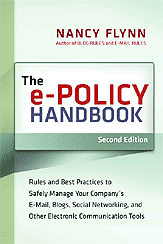- Bypass the Gatekeeper.
Few people have assistants screen eMail. The correct eMail address ensures your eLetter lands in the decision-maker's mailbox. Effective writing decreases the likelihood of your eLetter being trashed before it's read.
- Focus on the Customer.
A generic eSales letter that touts your company's size and capabilities probably means nothing to your prospect. Focus on the features and benefits that matter to the decision-maker.
- Remove Roadblocks.
What's the reader's biggest objection? Address it head-on. If, for example, the prospect doubts your product quality, lead with a glowing testimonial from a respected name in the industry.
- Write a Subject Line with OOMPH.
A small but powerful
weapon in the battle to capture reader attention, the subject line
can open doors or slam them shut. Subject lines should tell readers what
eLetters are about before they're opened. Attracting and Retaining Top Performers
, for example, says more than Employee Benefits.
- Never Begin with Thank You.
You only have a few seconds to grab the reader's attention. Start strong. Make your point in the first few words of
the first paragraph, then repeat, rephrase, and reiterate.
- Don't Give Prospects Reasons to Disqualify You.
Speedy doesn't mean sloppy. Every eLetter you write reflects on your professionalism and
credibility. Spellcheck and proofread.
- Beware Hidden Readers.
If confidentiality is an issue, don't use eMail. There is
no privacy in cyberspace. An inaccurate keystroke or the recipient's decision to forward your message could land it on unintended readers' screens, sabotaging sales and sinking careers.
- Write as Though Mom Were Reading.
Don't write anything you wouldn't
feel comfortable saying in an elevator crowded with customers, colleagues, and
competitors. Hundreds of sexual harassment and racial discrimination
lawsuits have resulted from improper eMail messages that were intended
as private jokes.
- Obey the Rules of Netiquette.
No shouting. No flaming. no spamming.
Translation: Don't write in capital letters. Don't send hostile messages.
Don't forward electronic junk mail.
- Remain Gender Neutral.
Your intended reader may be male, but the ultimate
decision-maker could be a woman. An eSales letter loaded with
masculine pronouns (he, his, him), could cost you this account for good.
- Don't Use eMail to Deliver Bad News.
Without the benefit of body language,
facial expressions, or intonation, eMail is no way to deliver bad news.
Use the phone to notify a customer of production delays or reject a prospect's
credit application.
- Copy with Care.
Send carbon copies (CC) and blind carbon copies (BCC) only
to people who need to read your message. Carbon recipients aren't required to
reply. So don't get angry when responses aren't forthcoming.
- Inquire About Attachments.
Some companies prohibit the opening of attachments. Before attaching that all-important proposal, ask if the customer would prefer to receive it as an attachment or in the field as part of the eLetter.
- Resist the Urge to CAPITALIZE!!!
The eye is accustomed to reading a mix
of upper and lowercase letters. Stick with standard style. And don't slap exclamation points onto the end of sentences!!! Pump up your writing with descriptive language and well-crafted sentences.
- Acknowledge eMail's Limitations.
eMail may be the best way to deliver news fast, but it's not necessarily the best route to a quick reply. Your reader is under no obligation to check in-coming messages regularly, if at all. It is inappropriate
to send a follow-up message demanding to know why you haven't received a response. For an immediate reply to a pressing issue, opt for a phone call or meeting.





